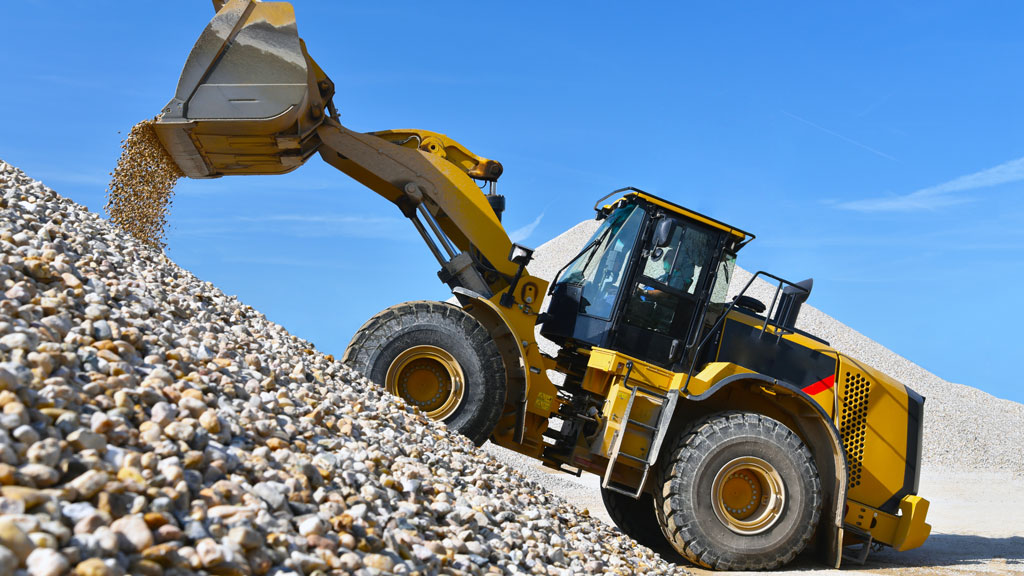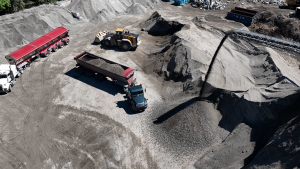The British Columbia Stone, Sand and Gravel Association (BCSSGA) is concerned that small family-owned gravel pits are being replaced by larger out-of-town mega-aggregate operations that result in longer commute times for trucks and cause more harm to the environment due to higher carbon emissions.
“Ninety per cent of the pollution that comes from gravel pits is actually not really from the pit – it’s from transportation and that also is 90 per cent of the cost. It’s also 90 per cent of what annoys the heck out of the travelling public,” says Dani Miller, president of the association which represents aggregate producers across B.C. “Nobody wants to be sharing the road with more dump trucks than they have to.”
The industry is consolidating into larger rural operations because smaller sand and gravel pits are treated much the same as major coal or gold mines, even though there’s a major difference, and are often subjected to the same requirements for expensive engineering, geotechnical, archeological, hydrogeological, terrestrial and aquatic habit assessments, as well as traffic, noise and dust modelling studies.
“We are seeing market consolidation year-over-year as the little pits are exhausted, and being replaced by much larger operations, much farther from town,” says Miller. “We are seeing hauling distance rise. The large companies are snapping up the little ones, in no small part because the family-owned ones don’t have the capacity to keep up with the technical and expensive permitting requirements.”
Although there are more than 2,000 aggregate mines and only around 200 gold or coal mines in B.C, the gravel producers are often smaller and have not been as organized, so the voices of the larger mines have been the loudest when regulations are being drafted by the Ministry of Energy, Mines and Low Carbon Innovation.
The BCSSGA, for example, is a non-profit organization with only one paid employee.
“Our efforts are by and large volunteer, and all those volunteers have day jobs, mining and supplying the gravel we all need,” says Miller.
Every small town in the province used to have a gravel pit within an hour or two’s drive but that is rapidly changing as companies consolidate and pits are moved further afield, she says.
“It’s going away because the Ministry of Mines has, for many years, not had a lot of good feedback from the aggregate producers and has subsequently started permitting little mines the same way as a giant coal or gold mine and it’s not doable. It’s not doable for family operations.
“Their permits cost a quarter of a million dollars and you’re only producing 10,000 tons a year. You’ll never even pay off getting the permit during the life cycle of the mine.”
Miller maintains there should be separate rules for smaller sand and gravel producers because they are inherently different from the larger mines. Aggregate sites are usually less than 100 acres and on previously disturbed land close to a town or city. The only chemicals used are fuel, grease and cleaners for equipment.
Coal and gold mines, on the other hand, are typically hundreds of kilometres from towns, require thousands of acres, as well as roads, dams and ponds, and must use large amounts of chemicals for some of their extraction processes which can have “significant impacts” on the environment, says Miller. Yet, both types of operations are required to do studies that can cost between $10,000 and $20,000 each.
And, if an aggregate operation produces 250,000 tonnes of “pay dirt,” a full environmental assessment must be done. Those usually start at $1 million which means a mid-size gravel pit is not often viable, says Miller.
Gravel underpins all construction, she says, and in a natural disaster, like the recent flooding that hit the Fraser Valley region of B.C., it’s the first material that’s needed to fix homes and highways, patch dikes and prevent erosion of powerline foundations and train tracks.
“Without it, disasters go from bad, to worse, quickly.”
The importance of a local gravel pit was highlighted when a dike along the Sumas River near Abbotsford was breached, says Miller. The dike had to be fixed in 48 hours before a second storm hit the region. Gravel couldn’t be trucked in along Highway 1 because it was under water but luckily there was a gravel pit only 15 minutes away which supplied aggregate for the repair by loading trucks around the clock.
“But, that only works in Abbotsford,” says Miller. “There are no quarries west of that, south of the Fraser. What happens when the Fraser spills her dikes in Richmond or in Delta?”
The BCSSGA is working with various government ministries to try to get a system that is more favourable to gravel mines. The association is also waiting on a pivotal decision regarding the District of Highlands near Victoria which is objecting to a quarry in the region, as the ruling will determine what municipalities can regulate.
“It is hard to gain political will to fix something when most voters will say, ‘Not in my backyard, please,’” says Miller. “We’re working to change that but as a small non-profit organization it certainly is difficult.”











Recent Comments